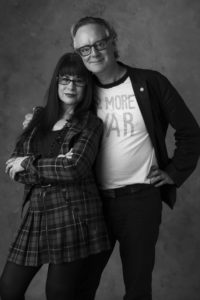The St. Augustine Lighthouse & Museum has partnered with renowned exhibit designers Peter and Sharon Exley from Architecture is Fun in Chicago, Ill., to create an exciting new museum exhibit.
ST. AUGUSTINE, FLA. – St. Augustine might not be the first city people think of in connection to the American Revolution, but the St. Augustine Lighthouse & Museum hopes to put the Nation’s Oldest PortSM into the conversation with a new exhibit scheduled to open in 2016. Plans for the new exhibit are under way with the museum’s design partners, Peter and Sharon Exley of the Chicago-based design firm Architecture is Fun.
“We are thrilled to be working with Peter, Sharon, and their team,” said Executive Director Kathy A. Fleming. “They are so talented and I know they are going to create something really fresh and exciting for our museum to share this story from the American Revolutionary War.”
Architecture is Fun has created exhibit designs all over the country including spaces at the Young At Art Museum (Davie, Fla.), Frost Art Museum (Miami, Fla.), Evanston Public Library (Evanston, Ill.) and the Latin School of Chicago (Chicago, Ill.).
Co-Founders and husband-and-wife duo Peter and Sharon recently visited the museum along with Terry LaVier from Morley Exhibits based out of Saginaw, Mich. The trio, who will manage the design, production and fabrication of the exhibit, met with museum staff to begin brainstorming for the project.
“Our goal is to capture the essence of this story and find the perfect lens in which to reflect it,” said Peter, who is a native of Liverpool, England. “Most people aren’t aware of this context of the American Revolution, but as we are getting a feel for this scenario, it’s really a story of resilience.”
The new exhibit will tell the story of a British Loyalist ship that ran aground while trying to enter the St. Augustine inlet on New Year’s Eve, 1782. Passengers on the vessel were a mix of civilians and soldiers who were forced to evacuate Charleston, S.C., after the British were defeated by the Colonists during the American Revolution. Though the ship’s passengers were able to get safely to shore, all of their possessions were lost to the sea.
Lighthouse archaeologists first encountered the wreck in 2009 and have been diving on the site every summer since 2010. The team’s scientific research process will also be part of the new exhibit.
Architecture is Fun will utilize interactive panels and modern technology to give guests an up-close look at how the lighthouse team carefully excavated this wreck thirty feet below the ocean’s surface and conserved the artifacts that were recovered.
Hundreds of items have been collected from the shipwreck, each of which has yielded a clue to telling this narrative. The artifacts, which include cannons, muskets, cauldrons, buttons, belt buckles and locks, are currently undergoing conservation at the museum in preparation for the upcoming exhibit.
Both the exhibit design and conservation process are being funded in part by the Department of State, Division of Historical Resources and the State of Florida. Matching funds have been provided by the Lastinger Family Foundation as well.
Guests can learn more about the shipwreck, the conservation process and see the artifacts up close on one of the museum’s daily guided tours. Lighthouse archaeologists will also have a tent with select items from the wreck on display at the annual Lighthouse Night Fest on March 7th from 4:00 p.m. to 9:00 p.m.
###
ABOUT THE ST. AUGUSTINE LIGHTHOUSE & MUSEUM:
A pivotal navigation tool and unique landmark of St. Augustine for over 140 years, the St. Augustine Light Station is host to centuries of history in the Nation’s Oldest PortSM. Through interactive exhibits, guided tours and maritime research, the 501(c)3 non-profit St. Augustine Lighthouse & Museum is on a mission to preserve, present and keep alive the story of the Nation’s Oldest Port SM as symbolized by our working lighthouse. We are the parent organization to the Lighthouse Archaeological Maritime Program (LAMP) and an affiliate of the Smithsonian Institution.




